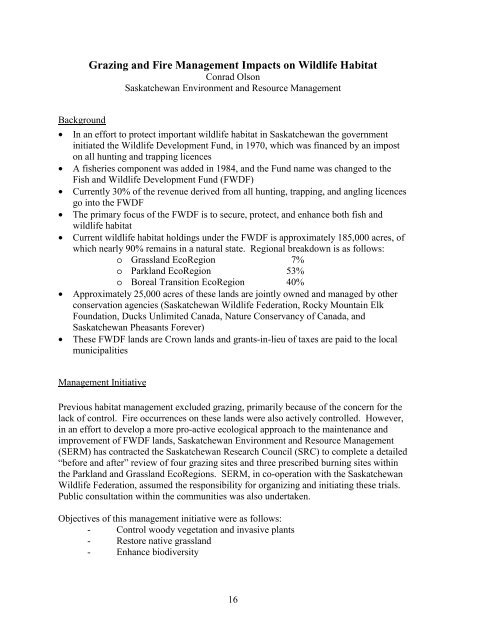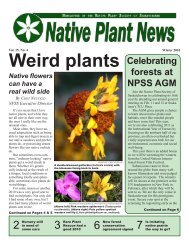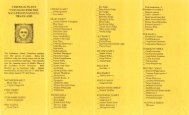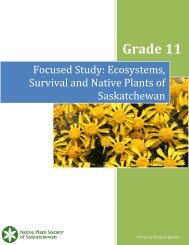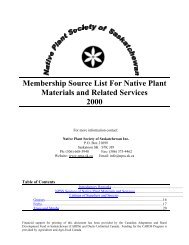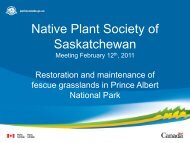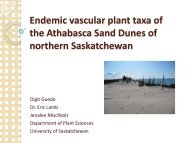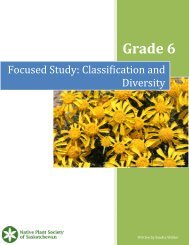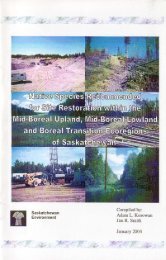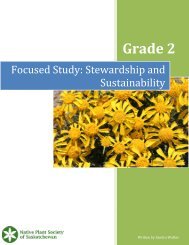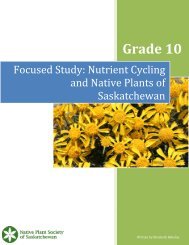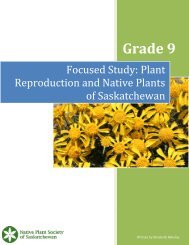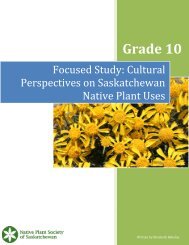Native Plants As Habitat For Wildlife - Native Plant Society of ...
Native Plants As Habitat For Wildlife - Native Plant Society of ...
Native Plants As Habitat For Wildlife - Native Plant Society of ...
You also want an ePaper? Increase the reach of your titles
YUMPU automatically turns print PDFs into web optimized ePapers that Google loves.
Grazing and Fire Management Impacts on <strong>Wildlife</strong> <strong>Habitat</strong><br />
Conrad Olson<br />
Saskatchewan Environment and Resource Management<br />
Background<br />
• In an effort to protect important wildlife habitat in Saskatchewan the government<br />
initiated the <strong>Wildlife</strong> Development Fund, in 1970, which was financed by an impost<br />
on all hunting and trapping licences<br />
• A fisheries component was added in 1984, and the Fund name was changed to the<br />
Fish and <strong>Wildlife</strong> Development Fund (FWDF)<br />
• Currently 30% <strong>of</strong> the revenue derived from all hunting, trapping, and angling licences<br />
go into the FWDF<br />
• The primary focus <strong>of</strong> the FWDF is to secure, protect, and enhance both fish and<br />
wildlife habitat<br />
• Current wildlife habitat holdings under the FWDF is approximately 185,000 acres, <strong>of</strong><br />
which nearly 90% remains in a natural state. Regional breakdown is as follows:<br />
o Grassland EcoRegion 7%<br />
o Parkland EcoRegion 53%<br />
o Boreal Transition EcoRegion 40%<br />
• Approximately 25,000 acres <strong>of</strong> these lands are jointly owned and managed by other<br />
conservation agencies (Saskatchewan <strong>Wildlife</strong> Federation, Rocky Mountain Elk<br />
Foundation, Ducks Unlimited Canada, Nature Conservancy <strong>of</strong> Canada, and<br />
Saskatchewan Pheasants <strong>For</strong>ever)<br />
• These FWDF lands are Crown lands and grants-in-lieu <strong>of</strong> taxes are paid to the local<br />
municipalities<br />
Management Initiative<br />
Previous habitat management excluded grazing, primarily because <strong>of</strong> the concern for the<br />
lack <strong>of</strong> control. Fire occurrences on these lands were also actively controlled. However,<br />
in an effort to develop a more pro-active ecological approach to the maintenance and<br />
improvement <strong>of</strong> FWDF lands, Saskatchewan Environment and Resource Management<br />
(SERM) has contracted the Saskatchewan Research Council (SRC) to complete a detailed<br />
“before and after” review <strong>of</strong> four grazing sites and three prescribed burning sites within<br />
the Parkland and Grassland EcoRegions. SERM, in co-operation with the Saskatchewan<br />
<strong>Wildlife</strong> Federation, assumed the responsibility for organizing and initiating these trials.<br />
Public consultation within the communities was also undertaken.<br />
Objectives <strong>of</strong> this management initiative were as follows:<br />
- Control woody vegetation and invasive plants<br />
- Restore native grassland<br />
- Enhance biodiversity<br />
16


